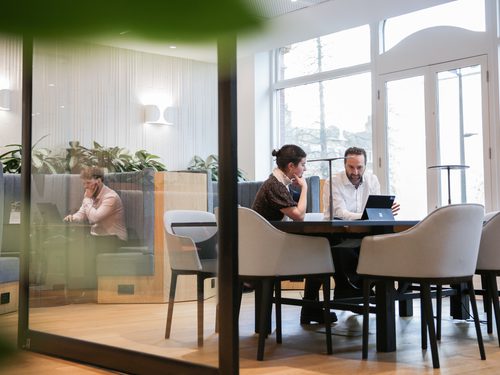The Evolution of the Workspace
With Inflation and Costs Rising, How Do Operators Adapt?
At September’s Global Co-working Unconference Community (GCUC) UK event, G&T Director Kelli Williams moderated a panel discussion on flexible workspaces and the impact of inflation. Kelli was joined on the panel by G&T Partner Rob Webber, Rupert Dean from X+Why and Danny Babington from Mindspace.
GCUC promotes itself on bringing together ‘decision-makers and game-changers’ in the flex industry, with this particular event focusing on “The Evolution of the Workplace” and providing unrivalled insights through keynotes, networking and panel sessions.
In this particular session, the panel were brought together to discuss the question, ‘With rising costs and inflation, how do operators design and plan space whilst managing customers’ needs and expectations.’
When tackling this question, responses from the panel centred around certain key topics, including:
- Mitigation of rising costs and inflation
- Adaptations in design
- Procurement and programme response
- Operational costs
- Target audience
Moderator Kelli Williams framed the discussion by reminding attendees that despite the prevailing doom and gloom in the headlines, the flex industry has the potential to offer further growth opportunities. Quoting Morgan Pryce, a London Commercial and Office Space Property Agent, “in the 2008-2009 recession, the services office market saw growth in the region of 20%”. Kelli then asked G&T’s Cost Manager Partner, Rob Webber, to tell us where the market is today and what his predictions are for the future.
Rob outlined how the last two years of unprecedented events – ie the pandemic, Brexit and a war in Europe – has affected the market. Firstly, with the post-COVID spike in inflation ‘when the world woke up’ and saw a huge surge in demand that was accompanied by disrupted supply chains in early 2021. Secondly, the conflict between Russia and Ukraine further exacerbated supply chain pressures, resulting in shortages of certain raw materials and a European-wide energy crisis. These pressures came directly after an uncertain period in which demand has been somewhat choked by the pandemic.
Looking forward, subject to some unpredictability due to recent Government announcements, Rob talked through his predictions of both the material and labour aspects of market. Rob pointed to recent signs of improvement with the supply of construction materials along with an easing in the rate of inflation but noted that a tight labour market will continue to put pressure on construction costs. However, Rob noted that this recent period of uncertainty did help to promote a degree of competitiveness among contractors keen to secure their pipeline of work towards the end of 2022 and into 2023. Kelli then steered the discussion around to how the flex industry can handle rising costs.
Mitigation of rising costs
With regards to how to mitigate against rising costs, the panel referenced the importance of engaging the supply chain early, and not just the main contractor but the sub-contractors and suppliers too. Early engagement allows clients to better understand any material availability and supply chain issues in advance. It also gives the project team an early opportunity to engineer solutions around design and material selection, or source in a more sophisticated way.
Adaptations in design
Danny Babington noted how Mindspace has experienced rapid growth over the last few years but understands there will likely be challenges ahead and believes the key is evolving with the occupiers. Following on from Rob’s earlier point, Danny noted how the COVID-era gave Mindspace time to re-focus and to “simplify, streamline, and be sensible” with their designs rather than going for bespoke, one-off products. This included utilising Cat A plus schemes, increasing soft furnishings and pulling back on more extravagant communal area designs – again, to simplify without being detrimental to the overall design of the project.
However, Rupert from X+Why claimed it’s about how to best procure the works and that it is not so much the design that needs changing. Rupert emphasised the focus should be on sourcing and explained that project teams should:
- Source local
- Be sustainable
- Talk to suppliers and contractors about availability and how operating costs are being passed on
Programme
As a project manager, Kelli reminded the panel that time is also a big factor in combating rising costs – both to avoid further inflationary creep in prices and impact on project preliminaries. She asked panellists what considerations they’ve made in terms of bringing projects forward and dealing with this issue.
The consensus among the panel was to understand the supply chain’s pipeline of work as soon as possible and to effectively utilise the supply chain’s knowledge. Bringing together knowledge about the availability of materials, lead times and design elements from each level of the supply chain makes it easier to resource the project, faster to manufacture and easier to install elements. Having this knowledge will present further opportunities to the project team and allow for a smarter and more efficient design and product.
In terms of mitigating programme risk, one solution provided by Rob Webber was to consider pre-purchasing materials, explaining that:
“The ability to negotiate and lock in programme and cost will give the project the certainty that’s needed in the current market.”Rob Webber
G&T partner
However, Rob acknowledged that this was reliant on having a strong relationship with suppliers.
Operational Costs
The discussion subsequently moved from construction costs to operational costs, such as energy usage, staff salaries and floor rentals, and how inflation is impacting rental incomes on these projects.
Short-Term Impacts
Operational costs are invariably being impacted by rising energy prices. However, this has stoked a positive response from the sector, pushing up operational efficiency higher up the agenda rather than simply passing on higher costs to tenants. This will hopefully allow operational costs to remain competitive and increase occupancy levels.
Long-Term Impacts
Operational costs are also being impacted by the cost-of-living crisis and resultant pressures on staff salary costs. The panellists noted there is an obligation on everyone to consider how ongoing cost-of-living pressures may drive labour costs and further fuel inflation. At the same time, panellists agreed that there needs to be extra focus on what makes workers happy, as well as investing to improve worker’s skill sets. It was emphasised how important it is to provide a working environment that can attract and retain talent, offering opportunities to develop and promote from within the business itself.
Target audience
Given that the flexible workspace market is driven by both the desire for high amenity as well as value-driven space, the question was asked whether this is having an impact on the target audience and whether Mindspace and X+Why would consider diversifying and changing their brand as a result.
Danny noted that no real change is needed but that it is important to be wiser to occupiers’ wish lists for the types of space required. Danny emphasised the importance of understanding where the value in design sits, and to consider what service is being offered in the market place and the value these amenities provide to occupiers. As a result, there have been a lot more service-led design criteria. One example provided was whether the inclusion of an auditorium space and meeting room hire spaces would be revenue generating or whether they would ultimately end up becoming unused space. There is greater focus on monetising certain elements that will add value to a future clients or tenants and that this comes back to the quality of design, local market conditions, and also the client base.
Rupert agreed and talked of how the key drivers for tenants are location, price and amenities. The scale of audience does not change, regardless of market conditions, but it is what they can provide the tenant over and above these three factors to better target their clientele. This includes enhancing their brand and values and considering how these can be communicated to the tenant, with it being much more about the building and the community they’re signing up to.
Key Takeaways:
For every cloud there is a silver lining. The construction industry is a flexible one and adapts to market conditions, finding opportunities where they exist. The flex industry is no different.
The key points from this panel discussion were:
- Be smarter with the design
- Source materials locally
- Understand and influence the supply chain
- Understand end user requirements and aspirations
- Having a robust and well researched pipeline
These key takeaways will help to mitigate against some of the strong inflationary pressures we’ve seen recently and address many of the procurement and supply chain issues. They will also help the local economy and take the pressure of both programme and cost. Homing in on the design ultimately enhances value for the tenant, helps to meet their requirements and also tame rising operational costs.
Image: © McGivern Photography.






